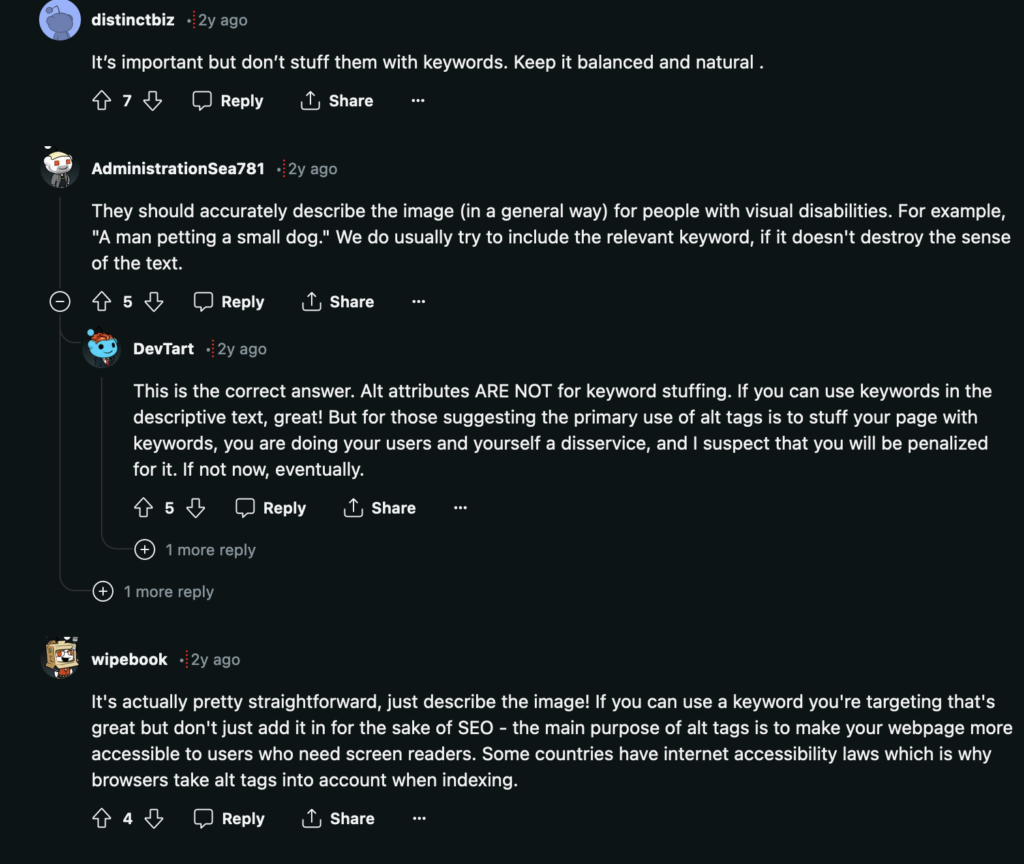Latest update: May 20, 2025
Alt text — short for “alternative text”— emerges as a fundamental component, seamlessly blending accessibility with SEO efficacy. This comprehensive guide delves into the realm of alt text, unraveling their significance in SEO strategies, elucidating best practices, and exploring their multifaceted benefits. Whether you’re a seasoned SEO expert or a newcomer aiming to optimize your website’s image content, understanding the nuances of alt text is pivotal.
Try to use text instead of images to display important names, content, or links. If you must use images for textual content, consider using the “ALT” attribute to include a few words of descriptive text
What Are Alt Text in SEO?
Text is well understood by search engines, but images are not. If you use images for important links on your page, they might not be understood or recognized as well as text is. One example is if your website menu has images that say “home” instead of text that says “home”. In that case, you would need to ensure the image has an ALT text that says “home”.
Alt Text Examples

Imagine if a websWite about animals had a homepage that only had two pictures on it and nothing else (no text). One picture of an elephant and one of a giraffe, linking to a page about each animal.
This might seem a clever and pleasant way to choose which animal you want to read about, but it would not follow this guideline.
An example of a website that follows this guideline

One important reason for having text links in addition to images is so that your webpage is accessible to those who are blind and are unable to use graphical links. Another important reason is that Googlebot cannot “see” what a picture is. Look over your website and make sure that if you are using images as links, they also have a text link as described above.
This guideline does not suggest images should not be used, it suggests that text be used to convey important names, content, and links. Notice I have used images in this description, yet this page is following the guidelines.
Often, for design reasons, your website or menu has images in it. Even though it has words on it it is still an image. An easy way to determine if a word on your webpage is an image or text is to see if you can highlight the text.
If you hold down your left mouse button while moving your mouse across a word, you will see the text highlighted, letter by letter. Any text contained in such images is unreadable to those who are blind and search engine crawlers. If search engine crawlers can not read it, search engines will not know that it is there.
The more accessible your website is to the sight impaired, the more accessible your site is to search engine crawlers.
There is a way to “tell” both blind users and search engine crawlers what an image is, that method is using ALT tags which are covered in detail on another guideline page – Make sure that your TITLE and ALT tags are descriptive and accurate.
How Important Are Alt Text For SEO?
Alt text emerges as a critical element not just for enhancing web accessibility, but also for bolstering a website’s SEO performance. These seemingly simple additions to your website’s images carry significant weight in how search engines interpret and rank your content. Understanding the importance of alt text is essential for anyone looking to optimize their online presence effectively.
Why Are Alt Text Indispensable for SEO?
- Improving Accessibility: Alt text serve as textual alternatives for images, providing context to visually impaired users through screen readers. This inclusivity not only improves user experience but also aligns with Google’s emphasis on accessibility, indirectly influencing your site’s SEO ranking;
- Enhancing Image Interpretation: Search engines, in their quest to understand and index content accurately, rely on alt text to “see” images. The descriptive text within alt tags allows search engines to index an image properly, ensuring it appears in relevant search queries and image searches;
- Boosting Organic Traffic: By incorporating targeted keywords into your image’s alt text, you make these images searchable, leading to increased visibility in search results. This strategic use of keywords can drive more organic traffic to your site, enhancing your SEO efforts;
- Reducing Bounce Rate: Alt text contributes to a richer user experience by providing context or explanations for images when they fail to load. This added layer of information can keep users engaged, potentially reducing bounce rates—an indirect yet valuable SEO benefit.
Image Alt Text SEO Best Practices
Implementing alt text effectively requires more than just adding descriptions to the images on your website. Adhering to SEO best practices for image alt text can significantly enhance your content’s visibility and accessibility. Here are concise, actionable guidelines to optimize your use of alt tags for SEO:
Accurately Describe the Image Content
The primary function of an alt text is to describe what an image depicts to both search engines and users who might not be able to see the image. Ensure your description is precise and gives context to the image.
Incorporate Relevant Keywords
Where appropriate, include relevant keywords in your alt text. This helps in indexing your image for those keywords, making it more likely to appear in search results. However, ensure the keywords naturally fit within the context of the image description.
Keep It Concise
While it’s important to be descriptive, brevity is key. Aim to keep your alt text under 125 characters. This ensures screen readers can efficiently convey the content of the image without overwhelming the user with too much information.
Avoid Keyword Stuffing
While keywords are essential, their overuse, known as keyword stuffing, can negatively impact your SEO. Use keywords thoughtfully and sparingly, ensuring they align naturally with the image’s content.
Use Human-Readable Language
Write alt text in plain language that’s easy for all users to understand, avoiding overly technical terms unless they are relevant to the image and your audience.
Don’t Use “Image of” or “Picture of”
Search engines already recognize alt tags as referring to images. Starting your alt text with these phrases is redundant and takes up valuable character space that could be used for more descriptive content.
Remember the Context
The best alt text considers the image’s role within the page. If the image includes text that’s crucial to understanding the content, include that text in the alt attribute.
Test for Accessibility
Use tools and resources to test your website’s accessibility, including how effectively your alt text conveys image content to users relying on screen readers. This not only enhances user experience but also contributes positively to your SEO.
Does Google Read Alt Text?
Google and other search engines read and interpret alt tags to grasp the content and purpose of images, using this information to rank pages in search results. The accurate and relevant description in alt tag aids in better indexing and visibility in image searches.
Understanding how Google interacts with alt tags is crucial for SEO practitioners aiming to optimize their websites for better search engine visibility. Here’s a distilled overview of Google’s approach to reading alt tags:
- Indexing Images: Google reads alt text as part of its image indexing process. The descriptive text in alt tags helps Google’s algorithms understand and classify images, improving their visibility in Google Images and related search queries;
- Enhancing Search Relevance: Alt text contributes to the overall search relevance of a page. By providing context about an image, alt text helps Google match a page to relevant search queries, potentially improving its ranking in search results;
- Accessibility Consideration: Google acknowledges the importance of web accessibility. Websites that use alt text effectively can be seen as offering a better user experience, aligning with Google’s aim to prioritize user-friendly websites in its search results.
By the way, to understand exactly how our site gets to the top of Google, we recommend you read this guide.
How To Use ChatGPT To Write Alt Text?
ChatGPT, with its advanced natural language processing capabilities, can be a powerful tool for generating descriptive and SEO-friendly alt text for images. Here’s how to effectively use ChatGPT for this purpose:
Provide Context
When requesting alt text from ChatGPT, offer as much context about the image as possible. Details about the image’s content, its role on the page, and any relevant keywords can guide ChatGPT to generate more accurate and useful descriptions.
Specify SEO Goals
Inform ChatGPT of your SEO objectives. If you aim to target specific keywords, include this in your request. ChatGPT can incorporate these keywords naturally into the alt text, aligning with SEO best practices.
Emphasize Brevity and Clarity
Request that ChatGPT keeps the alt text concise and to the point, ideally under 125 characters. This ensures the alt text is effective for SEO while remaining accessible for screen reader users.
Iterate for Perfection
Don’t settle for the first response. If the initial alt text doesn’t fully meet your expectations, refine your prompts or provide additional details to ChatGPT for improved outcomes.
Use ChatGPT’s Creativity
For images that are more abstract or artistic, leverage ChatGPT’s creative capabilities to draft alt text that captures the essence or emotion of the image, adding depth to your content.
How to Check Compliance with This Guideline for Your Website?
The best possible way to follow this guideline is to ensure that all navigational components of your website use text, not images. This means that the link to your home page is a text link that says “home”, not an image with a house on it.
If you have image-based navigation then you must have accurate alt text every image on your website needs to have an accurate alt text. You can check the alt tags of your webpage with the image ALT tool which will examine a webpage to find all the images and report on how well the image is following the Google webmaster guidelines.
Top Answers of Reddit About Alt Text in SEO
Let’s delve into the insights and recommendations provided by SEO specialists within the SEO community of Reddit. In particular, we’ll focus on their valuable advice regarding alt text.

The main tips are:
- Avoid keywords stuffing and make alt text more natural;
- Write alt text more descriptively to make it accessible to users using screen readers.
Conclusion
Alt text serves as a bridge between visual content and search engine visibility, enhancing both accessibility and SEO. This article has explored the multifaceted role of alt text, from their impact on Google’s indexing to their significance in web accessibility and SEO rankings. By implementing the best practices outlined, such as using descriptive, keyword-relevant alt text and leveraging tools like ChatGPT for content creation, website owners can ensure their images are not only accessible to all users but also poised for better performance in search results.
Understanding and applying these guidelines effectively is not just about adhering to SEO best practices; it’s about contributing to a more inclusive and accessible web. As search engines continue to evolve, the emphasis on meaningful, user-focused content becomes increasingly apparent. Therefore, optimizing your website’s images with thoughtful alt text is a step towards creating a user-friendly, SEO-optimized, and accessible online presence. Remember, in the realm of SEO and web design, attention to detail—like optimizing alt tags—can make a significant difference in your website’s reach and impact.


